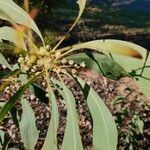Unarmed, erect shrub or tree up to 4 m high. Branchlets with not very prominent yellowish rib. Phyllodes falcate, glabrous with prominent main vein and margins, reticulately penninerved, acute or obtuse, broadest above the middle, very attenuate at the base, (9.5-)12-19 by 1.2-4 cm, 4.5-12 times as long as broad, with a slit-like gland at the base, pulvinus c. 5 mm. Inflorescences consisting of heads of 15-20 yellow flowers in axillary racemes. Pods linear, ± flat, with nerve-like margin and transverse reticulate veins, to c. 10 by 0.5-0.7 cm. Seeds 2-2.2 by 0.8-1 mm, pleurogram closed, funicle running round the top of the seed to the base, then folded back and thickened to form a clavate aril on one side at the base.


